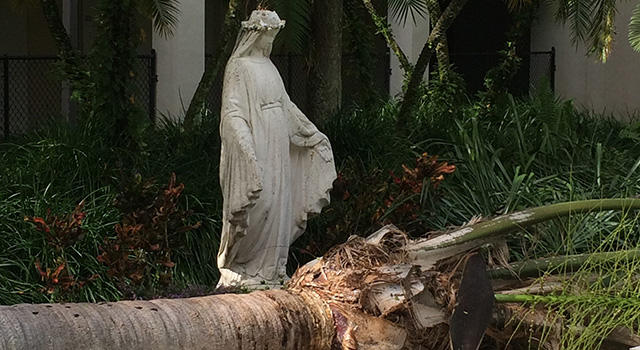By Tom Tracy - Florida Catholic
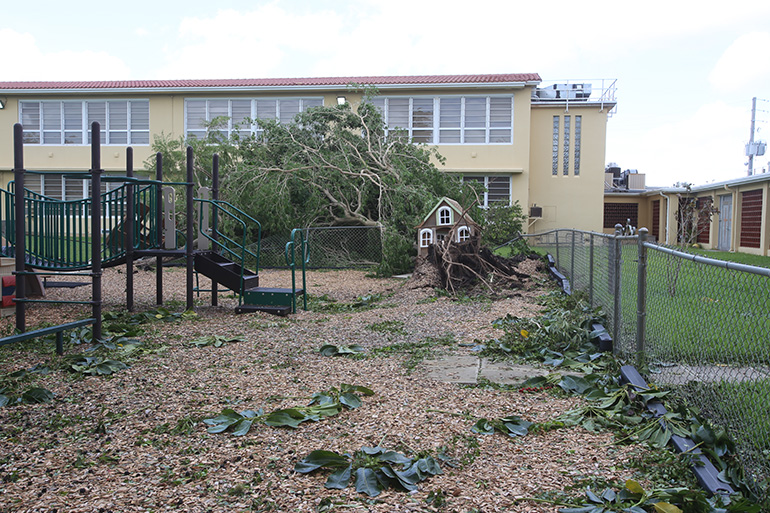
Photographer: MARLENE QUARONI | FC
One of the playgrounds at St. Rose of Lima School in Miami Shores shows damage caused by a tree falling down during Hurricane Irma. Damage from the storm in the Archdiocese of Miami was mercifully good: a lot of tree damage, some flooding but most of the structures, including those in the hardest-hit Keys, held up very well.
MIAMI | Hurricane Irma’s destructive winds blew wreckage and disruption throughout Florida.
But the executive director of the Archdiocese of Miami’s Catholic Charities is particularly anxious to assess the devastation in Monroe County.
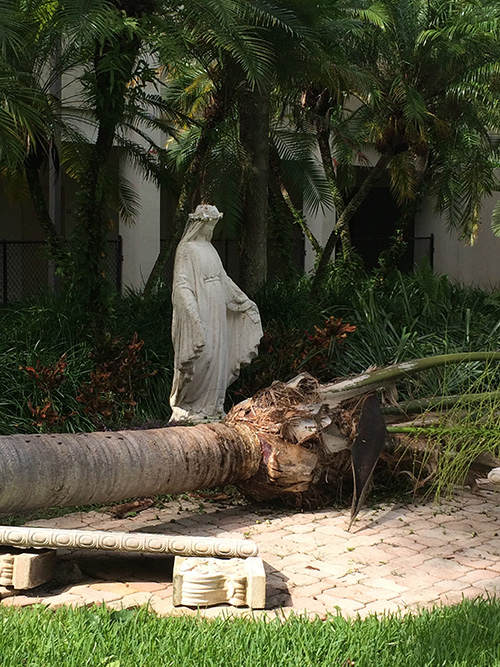
Photographer: COURTESY PHOTO
Father Alexander Rivera, parochial vicar at Epiphany Parish in South Miami, posted this picture on his Facebook page around midday Sept. 11. His caption: "Blessed Mother be like: 'What you got, Irma?' Giving thanks to God that the worst is behind us and now for the cleanup!"
Speaking with the Florida Catholic Sept. 13, Deacon Richard Turcotte said the Overseas Highway through the Florida Keys was not yet fully open, making it impossible to get a first-hand look at the devastation to the Middle and Lower Keys.
The area reportedly sustained severe damage from Irma. Those high priority places include Marathon, Cudjoe Key, Big Pine Key and Key West.
“It looks like (news reports show) there is absolutely nothing left in Marathon,” Deacon Turcotte said, noting that poor cell phone communication and transportation logistics have been slowing the flow of information several days after the hurricane.
“I am trying to establish some communications. I plan to talk with some of the pastors there and do some distributions of water and food from parishes, and once we get the highway opened up we can talk about those distributions to the Keys.”
In terms of Hurricane Irma’s impact on Miami-Dade and Broward County, it appears that “there wasn’t the devastation that we say in the Keys, so the greatest challenge will be getting services up and running there,” Deacon Turcotte said.
State officials this week confirmed a 23rd death attributable to Hurricane Irma in Florida, with eight of those fatalities in Monroe County and another eight at a nursing home in Hollywood. Irma will be remembered as one of the Atlantic’s strongest hurricanes on record, with peak winds of 185 mph and Category 4 strength when it landed in the Florida Keys. Some sources are predicting that insured losses from the storm could total $18 billion in the U.S.
In addition to five Catholic parishes and one school throughout the Florida Keys, the region is home to a Catholic Charities-affiliated residential program, New Life Workforce Housing in Key West, and other homelessness prevention programming for Monroe County.
Workforce Housing had 32-bed capacity and Catholic Charities was in the process of trying to build 37 new units in Key West, but Hurricane Irma’s impact will likely set the plans behind schedule, Deacon Turcotte noted.
He said his Charities team has been working in three broad teams following the hurricane, with a goal of pulling together damage assessment to facilities, deciding on Charities programming status and prioritizing future response efforts, which are expected to be long term in focus.
“I have been taking all that information and then determining where the greatest damage is, and we can say it is Marathon so far,” Deacon Turcotte said.
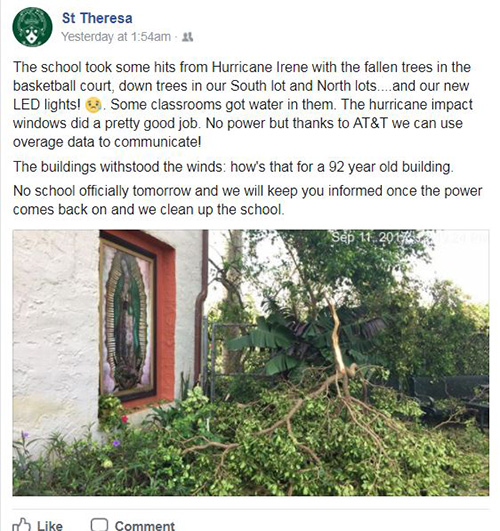
Photographer: COURTESY PHOTO
St. Theresa School in Coral Gables was one of many archdiocesan schools and parishes that communicated with parishioners and parents via social media.
“We are having daily conference calls with other state Charities agencies and Catholic Charities USA about available resources and stages of recovery,” he said, adding that the seven Catholic Charities agencies of Florida spoke by phone Sept. 13 with the president of Catholic Charities USA, Dominican Sister Donna Markham, who may later make a personal assessment tour of the area.
Deacon Turcotte said he recently examined a satellite image provided by NOAA, the National Oceanic and Atmospheric Administration, which indicates some good news that will have to be confirmed on the ground later: “From what we can tell of the satellite image of Key West it looks like our structures are still standing but we don't know about water damage, and it might be a few weeks to do damage assessments and even longer before we can bring the clients back in.”
As soon as authorities restore access to Key West, Charities staff will be heading down for a quick look. “We don't want to strain the infrastructure down there: a very quick in and out and then go back later with needed supplies.”
Right now, the Keys infrastructure, he said, cannot tolerate lots of volunteers and people of good will coming down to an area with minimal services, power outages, shortages of gasoline, foodstuffs and crippled infrastructure.
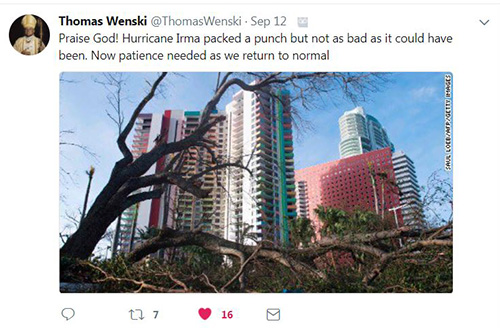
Photographer: COURTESY PHOTO
On Sept. 12, Archbishop Thomas Wenski tweeted "Praise God! Hurricane Irma packed a punch but not as bad as it could have been. Now patience needed as we return to normal." It was one of many social media posts which kept the faithful in touch with their churches and priests during and after the storm.
Before Hurricane Irma arrived, Catholic Charities programs across the archdiocese had evacuated residential clients in anticipation of the storm, including relocating some 52 unaccompanied minors living in Miami to temporary housing in Houston.
Residential clients at St. Luke’s Center for alcohol abuse and substance addiction and New Life Family Center in Miami were also temporarily relocated. Many of those residents are returning as power is restored in the region.
Many Charities staff have been working from home throughout the hurricane crisis until South Florida gets back to normal.
“In the future, we may need to do outreach for long term recovery, but right now it is too early to evaluate how to respond in Miami and Fort Lauderdale areas,” Deacon Turcotte said. He noted that the Federal Emergency Management Agency (FEMA) will eventually publish data that will give some indications of who needs help and particularly who was unable to get federal assistance.
With each hurricane come lessons for emergency services providers, including Catholic Charities. Nonprofits here have organized themselves into regions and geographic sectors to share emergency resources. Hurricane Irma proved unique, Deacon Turcotte said, for having directly impacted almost every diocese in the state, including the Diocese of Pensacola-Tallahassee, which had the distinction of receiving many of the evacuees from other regions.
Hurricane Irma was also responsible for causing significant harm to populations in the Caribbean islands, including the U.S. Virgin Islands.
For more information or to make a to Hurricane Irma-related donation visit: http://www.ccadm.org.
Corrected: The original article mentioned Marathon Key. It should have read only Marathon, a city in the middle of the Florida Keys, specifically Knight's Key, Boot Key, Key Vaca, Fat Deer Key, Long Point Key, Crawl Key and Grassy Key islands.
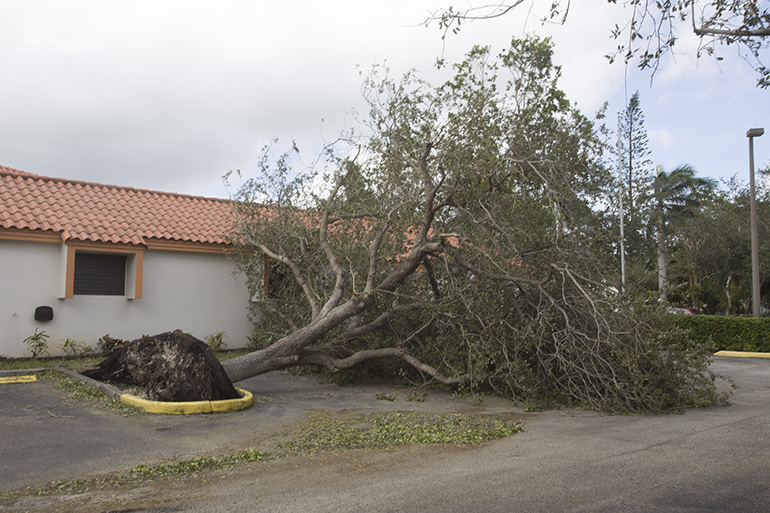
Photographer: MARLENE QUARONI | FC
A fallen tree blocks the parking lot at St. Martha Church's parish hall, next to the archdiocesan Pastoral Center in Miami Shores. The aftermath of Hurricane Irma in the Archdiocese of Miami was mercifully good: a lot of tree damage, some flooding but most of the structures, including those in the hardest-hit Keys, held up very well.
